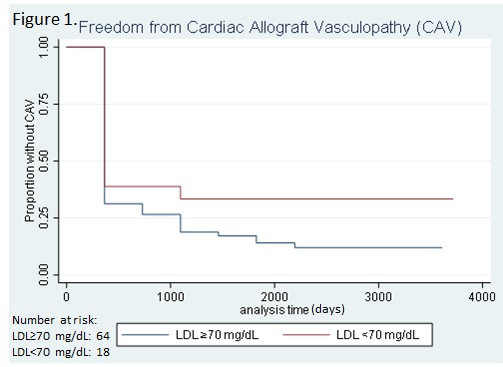Taking it to the Max: Extremely Low LDL May Provide Benefit for Prevention of Cardiac Allograft Vasculopathy
1Pharmacy, Stanford Health Care, Stanford, CA, 2University Health Network, Toronto, ON, Canada, 3Medicine, Stanford University, Stanford, CA, 4Cardiac Transplant, Stanford University, Stanford, CA
Meeting: 2020 American Transplant Congress
Abstract number: C-284
Keywords: Graft arterlosclerosis, Heart transplant patients, HMG-CoA reductase inhibitor, Hypercholesterolemia
Session Information
Session Name: Poster Session C: Heart and VADs: All Topics
Session Type: Poster Session
Date: Saturday, May 30, 2020
Session Time: 3:15pm-4:00pm
 Presentation Time: 3:30pm-4:00pm
Presentation Time: 3:30pm-4:00pm
Location: Virtual
*Purpose: Routine use of statins is the only Class I ISHLT recommendation in heart transplantation (HT) to reduce cardiac allograft vasculopathy (CAV) and improve survival. However, there are no recommendations on target LDL level. The purpose of this study was to determine if LDL <70 mg/dL provided any additional benefit to the prevention of CAV.
*Methods: This was a retrospective study in adult HT recipients between 1/2008 and 11/2014 at a single institution. All patients were started on statin therapy ≤90 days of HT if possible. Patients were separated into two groups: LDL <70 mg/dL vs. LDL ≥70 mg/dL. The primary outcome was freedom from CAV at 5 years. Development of CAV was determined by intravascular ultrasound (IVUS) or angiography. Baseline characteristics were compared using χ2 and t-tests as appropriate. Time to development of CAV was determined by Kaplan-Meier method. Multivariate analysis was performed using Cox regression.
*Results: 82 patients were included in this study. 83% were prescribed a statin ≤90 days of HT. The cohort was predominantly male (79%), Caucasian (60%), and with 28% having ischemic cardiomyopathy as the indication for HT. Other baseline characteristics were similar (p>0.05) between groups, including age, BMI, CMV status, and donor-derived CAV (baseline mean intimal thickness >0.5 mm). 66% received induction with anti-thymocyte globulin. At 1 year post-HT, the proportion of patients on the following maintenance immunosuppressives were: tacrolimus (70%), cyclosporine (25%), mycophenolate (90%), sirolimus (7%), and prednisone (70%). At 5 years post-HT, those with LDL <70 mg/dL had greater freedom from CAV than those with LDL ≥70 mg/dL (p=0.038; Figure1). The only significant predictor of CAV on univariate analysis was donor age. In the multivariate analysis, only donor age remained significant (p=0.026).
*Conclusions: In this study, LDL <70 mg/dL was associated with less CAV development at 5 years post-HT. This is important as better CAV outcomes may lead to better survival. More aggressive, goal-directed LDL lowering may have benefit over fixed-dose statin use after HT. The differential impact of LDL lowering in comparison to other strategies to address CAV requires further study.
To cite this abstract in AMA style:
Lee R, Henricksen EJ, Moayedi Y, Feng KY, Han J, Yang W, Imai R, Teuteberg JJ, Khush KK. Taking it to the Max: Extremely Low LDL May Provide Benefit for Prevention of Cardiac Allograft Vasculopathy [abstract]. Am J Transplant. 2020; 20 (suppl 3). https://atcmeetingabstracts.com/abstract/taking-it-to-the-max-extremely-low-ldl-may-provide-benefit-for-prevention-of-cardiac-allograft-vasculopathy/. Accessed December 21, 2025.« Back to 2020 American Transplant Congress

